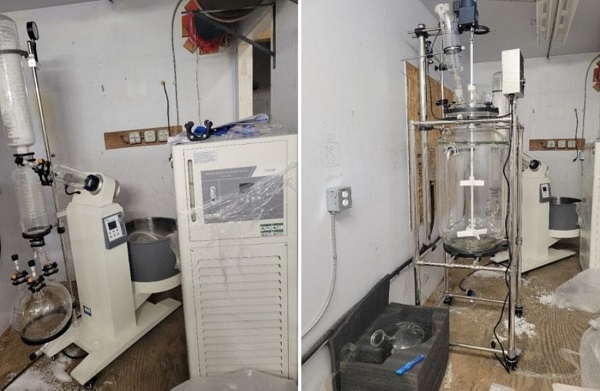Opinion
Ancient Romans did it. Councillor Buchanan thinks Red Deer can do it. Why not do it? Harness our water?

If Red Deer had a guaranteed year round source of flowing water, should we harness it for Hydroelectricity? What if we had a flow rate that was only strong enough to power city buildings? Should we investigate it? If we knew parts of the equation could we not ask?
City Councillor Buck Buchanan thinks it should be looked into. Why?
The city has a guaranteed source that has been recently upgraded to 72,500 cubic meters per day. The source is our Wastewater Treatment Plant. It pumps treated water into the Red Deer River year round and it is not going to stop anytime soon.
The raw wastewater goes through different cycles and/or processes before it is released as clean water. Treated wastewater leaves the plant area through a channel before being released into the Red Deer River.
The upgraded capacity of Red Deer’s wastewater treatment plant is 72,500 cubic meters of water per day or 2.6 million cubic feet per day.
The energy in these moving waters is being wasted. Why not harness it as Hydroelectricity.
Hydroelectricity is electricity produced by movement of water. It is usually made with dams that block a river to make a reservoir or collect water that is pumped there. When the water is released, the pressure behind the dam forces the water down pipes that lead to a turbine. Our wastewater treatment plant acts like a dam as it holds back water for treatment.
So just how do we get electricity from water? Actually, hydroelectric and coal-fired power plants produce electricity in a similar way. In both cases a power source is used to turn a propeller-like piece called a turbine, which then turns a metal shaft in an electric generator, which is the motor that produces electricity. A coal-fired power plant uses steam to turn the turbine blades; whereas a hydroelectric plant uses moving water to turn the turbine. The results are the same.
People have been using the power of moving water to run water wheels and mills for more than 2,000 years. Modern power plants today convert that mechanical energy into electricity.
Tides, ocean currents, waterfalls, rivers… Moving water is a constant source of energy ready to be harnessed. Hydroelectric energy is obtained by using a turbine to convert the kinetic energy of a river or waterfall into mechanical energy, and then an alternator to transform it into electrical energy.
There are two main kinds of hydroelectric generating stations: reservoir, and
run-of-river (ROR).
A generating station with reservoir uses a dam to create an artificial lake. A run-of-river generating station has no reservoir but offers the advantage of producing electricity without having to store the water.
Hydro power plants produce minimal greenhouse gases and are a source of clean, non-polluting energy. The evaporation/condensation cycle also makes hydro energy renewable. The above qualities pertain particularly to ROR plants, which produce energy from the natural water flow, which means that the impact on the landscape, ecosystem and neighbouring communities is considerably reduced. It also costs much less to produce electricity at an ROR plant.
Such properties make ROR hydroelectricity a sensible choice, for economic, social and environmental reasons.
Run-of-river generating stations are not very complicated. Flowing water is channelled through the intake and enters a penstock, which causes it to flow with greater speed and force to the turbine. The turbine is activated by the force of the water, and it, in turn, runs the alternator to produce electricity. The water then flows down the tailrace and returns to the river.
The viability of a site and the electricity it can produce are determined by two factors: drop height and water flow volume.
Hydroelectric energy has been in use for thousands of years. Ancient Romans built turbines, which are wheels turned by flowing water. Roman turbines were not used for electricity, but for grinding grains to make flour and breads.
Water mills provide another source of hydroelectric energy. Water mills, which were common until the Industrial Revolution, are large wheels usually located on the banks of moderately flowing rivers. Water mills generate energy that powers such diverse activities as grinding grain, cutting lumber, or creating hot fires to create steel.
Hydroelectric power is also very efficient and inexpensive. “Modern hydro turbines can convert as much as 90% of the available energy into electricity. The best fossil fuel plants are only about 50% efficient. In the US , hydropower is produced for an average of 0.7 cents per kilowatt-hour (kWh).
Since we know we have a flow rate of 72,500 cubic meters per day, could we not ask an expert if we could harness it for hydroelectricity? If so how much could we produce and how much would it cost?
Like Councillor Buchanan, I am just asking.
Internet
US government gave $22 million to nonprofit teaching teens about sex toys: report

From LifeSiteNews
The Center for Innovative Public Health Research’s website suggests teenage girls make their ‘own decisions’ about sex and not let their parents know if they don’t want to.
For almost a decade, the U.S. government funded a group that actively works to teach kids how to use sex toys and then keep them hidden from their parents to the tune of $22 million.
According to investigative reporter Hannah Grossman at the Manhattan Institute, The Center for Innovative Public Health Research (CIPHR) has been educating minors about sex toys with public funds.
Records show that the millions given to the group since 2016, according to its website, go toward “health education programs” that “promote positive human development.”
However, the actual contents of the programs, as can be seen from comments from CIPHR CEO Michele Ybarra, seem to suggest that its idea of “human” development is skewed toward radical sex education doctrine.
In 2017, CIPHR launched Girl2Girl, which is funded by federal money to promote “sex-ed program just for teen girls who are into girls.” Its website lets users, who are girls between ages 14 and 16, sign up for “daily text messages … about things like sex with girls and boys.”
The actual content of some of the messages is very concerning. Its website notes that some of the texts talk about “lube and sex toys” as well as “the different types of sex and ways to increase pleasure.”
The website actively calls upon teenage girls to make their “own decisions” and not let their parents know if they don’t want to.
Grossman shared a video clip on X of Ybarra explaining how they educate minors about the use of “sex toys” and dealing with their parents if they are found out.
The clip, from a 2022 Brown University webinar, shows Ybarra telling researchers how to prepare “young person(s)” for her research.
She said if they are doing “focus groups,” she will ask them, “Okay, so what happens if somebody comes into the room and sees words like penis and sex toys on your screen — on your computer screen or on your phone? What if it’s your mom?’”
In 2023, CIPHR launched Transcendent Health, which is a sex-education program for minors who are gender confused. This initiative received $1.3 million of federal grant money that expired last month.
Grossman observed that the federal government “should not fund programs that send sexually explicit messages to minors and encourage them to conceal these communications from parents.”
She noted that in order to protect children and “prevent further harm,” U.S. President Donald Trump’s Department of Health and Human Services “should immediately cancel CIPHR’s active contract and deny its future grant applications.”
“By doing so, the Trump administration can send a clear message: Taxpayers will no longer foot the bill for perverted ‘research’ projects,” she noted.
The Trump administration has thus far, through the Department of Government Efficiency (DOGE), exposed billions in government waste and fraud. Many such uses of taxpayer dollars are currently under review by the administration, including pro-abortion and pro-censorship activity through USAID, “Diversity, Equity, and Inclusion and neo-Marxist class warfare propaganda” through the National Science Foundation, and billions to left-wing “green energy” nonprofits through the Environmental Protection Agency.
Business
Canadian Police Raid Sophisticated Vancouver Fentanyl Labs, But Insist Millions of Pills Not Destined for U.S.

 Sam Cooper
Sam Cooper
Mounties say labs outfitted with high-grade chemistry equipment and a trained chemist reveal transnational crime groups are advancing in technical sophistication and drug production capacity
Amid a growing trade war between Washington and Beijing, Canada—targeted alongside Mexico and China for special tariffs related to Chinese fentanyl supply chains—has dismantled a sophisticated network of fentanyl labs across British Columbia and arrested an academic lab chemist, the RCMP said Thursday.
At a press conference in Vancouver, senior investigators stood behind seized lab equipment and fentanyl supplies, telling reporters the operation had prevented millions of potentially lethal pills from reaching the streets.
“This interdiction has prevented several million potentially lethal doses of fentanyl from being produced and distributed across Canada,” said Cpl. Arash Seyed. But the presence of commercial-grade laboratory equipment at each of the sites—paired with the arrest of a suspect believed to have formal training in chemistry—signals an evolution in the capabilities of organized crime networks, with “progressively enhanced scientific and technical expertise among transnational organized crime groups involved in the production and distribution of illicit drugs,” Seyed added.
This investigation is ongoing, while the seized drugs, precursor chemicals, and other evidence continue to be processed, police said.
Recent Canadian data confirms the country has become an exporter of fentanyl, and experts identify British Columbia as the epicenter of clandestine labs supplied by Chinese precursors and linked to Mexican cartel distributors upstream.
In a statement that appears politically responsive to the evolving Trump trade threats, Assistant Commissioner David Teboul said, “There continues to be no evidence, in this case and others, that these labs are producing fentanyl for exportation into the United States.”
In late March, during coordinated raids across the suburban municipalities of Pitt Meadows, Mission, Aldergrove, Langley, and Richmond, investigators took down three clandestine fentanyl production sites.
The labs were described by the RCMP as “equipped with specialized chemical processing equipment often found in academic and professional research facilities.” Photos released by authorities show stainless steel reaction vessels, industrial filters, and what appear to be commercial-scale tablet presses and drying trays—pointing to mass production capabilities.
The takedown comes as Canada finds itself in the crosshairs of intensifying geopolitical tension.
Fentanyl remains the leading cause of drug-related deaths in Canada, with toxic supply chains increasingly linked to hybrid transnational networks involving Chinese chemical brokers and domestic Canadian producers.
RCMP said the sprawling B.C. lab probe was launched in the summer of 2023, with teams initiating an investigation into the importation of unregulated chemicals and commercial laboratory equipment that could be used for synthesizing illicit drugs including fentanyl, MDMA, and GHB.
The Bureau is a reader-supported publication.
To receive new posts and support my work, consider becoming a free or paid subscriber.
Invite your friends and earn rewards
-

 Also Interesting1 day ago
Also Interesting1 day agoMortgage Mayhem: How Rising Interest Rates Are Squeezing Alberta Homeowners
-

 2025 Federal Election2 days ago
2025 Federal Election2 days agoConservative Party urges investigation into Carney plan to spend $1 billion on heat pumps
-

 Also Interesting2 days ago
Also Interesting2 days agoExploring Wildrobin Technological Advancements in Live Dealer Games
-

 2025 Federal Election2 days ago
2025 Federal Election2 days agoCommunist China helped boost Mark Carney’s image on social media, election watchdog reports
-

 2025 Federal Election2 days ago
2025 Federal Election2 days agoFifty Shades of Mark Carney
-

 2025 Federal Election2 days ago
2025 Federal Election2 days agoCorporate Media Isn’t Reporting on Foreign Interference—It’s Covering for It
-

 Business1 day ago
Business1 day agoStocks soar after Trump suspends tariffs
-

 Justice2 days ago
Justice2 days agoCanadian government sued for forcing women to share spaces with ‘transgender’ male prisoners





